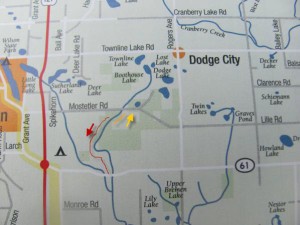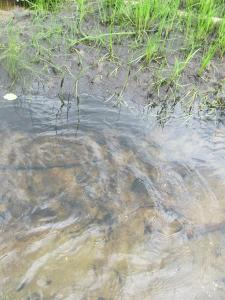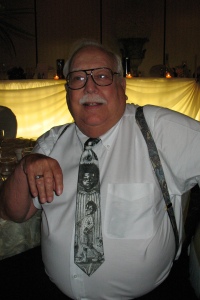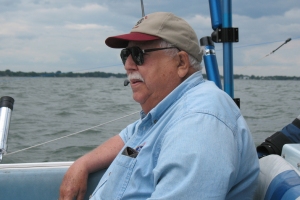Rooted or Why Trees Don’t Frolic
 The sun rose slowly, covering the land with its warm, rich light. Here and there, small furry creatures scurried through the underbrush in search of their morning meal. In a large grassy clearing, a nimble Timbleflit performed his morning dance. His blue and yellow body shining brightly in the early morning light as he jumped high in the air, flipped completely over and came down again on his three broad feet, his cheerful “tip, tip, tip” filling the air with sound. With the approach of a small, toothed Treke, he hopped quickly in the dense woods nearby, his small white powderpuff tail disappearing after him.
The sun rose slowly, covering the land with its warm, rich light. Here and there, small furry creatures scurried through the underbrush in search of their morning meal. In a large grassy clearing, a nimble Timbleflit performed his morning dance. His blue and yellow body shining brightly in the early morning light as he jumped high in the air, flipped completely over and came down again on his three broad feet, his cheerful “tip, tip, tip” filling the air with sound. With the approach of a small, toothed Treke, he hopped quickly in the dense woods nearby, his small white powderpuff tail disappearing after him.
At the edge of the clearing Tilly Tree watched the Timbleflit disappear with a tinge of sorrow. She enjoyed watching this early morning ritual even though she had seen it many times before.
Tilly yawned and stretched her branches. Turning she skipped toward the lake, moving as easily on her strong supple roots as nimbly as the Timbleflit had moved on its legs. Tilly looked into the lake and she saw her reflection and smiled. Even after these 40 years she was a good-looking tree. She stood tall and majestic with good cover, no dead branches, and her bark still had a good color. Yes, she had a lot to be proud of.
She heard a whistle and turned toward it. She smiled as she recognized its source. “Good morning, Mary Maple,” she said cheerfully.
 “Hi,” Mary replied as she extended a limb and poked at a small Bitterkiss that was hiding in Tilly’s upper branches. The Bitterkiss shrieked as it lost its footing and tumbled toward the ground, before its long soft yellow fur opened like a flower to catch the wind that allowed it to fall gently, blowing to and fro like a leaf, but leaving a slightly unpleasant odor in its wake. Mary watched it until it floated to the ground and scampered away, then said, “You seem to be in an extra good mood today.”
“Hi,” Mary replied as she extended a limb and poked at a small Bitterkiss that was hiding in Tilly’s upper branches. The Bitterkiss shrieked as it lost its footing and tumbled toward the ground, before its long soft yellow fur opened like a flower to catch the wind that allowed it to fall gently, blowing to and fro like a leaf, but leaving a slightly unpleasant odor in its wake. Mary watched it until it floated to the ground and scampered away, then said, “You seem to be in an extra good mood today.”
“And with good reason. I’m going to see Elwood,” Tilley replied.
Elwood was a tall handsome oak and Tilly’s treefriend. He was also the top tree in the forest. It was his job to make all the decisions concerning the welfare of the tree tribe.
“Well, have fun,” Mary said, walking away, her leaves shaking slightly both from the breeze and from envy, for all the girl trees considered Elwood to be a good catch. After all, he came from sturdy stock and was not simple softwood.
Soon, Tilly was skipping toward Elwood’s home, her manicured roots barely touching the ground and a song on her bark.
 Suddenly, below her she saw a large foot lash out and entangle itself in her roots. With a cry she pitched forward onto the hard ground. Tilly laid there yelling and hoping help would arrive. After many hours in the hot sun with termites swarming over her, it finally did.
Suddenly, below her she saw a large foot lash out and entangle itself in her roots. With a cry she pitched forward onto the hard ground. Tilly laid there yelling and hoping help would arrive. After many hours in the hot sun with termites swarming over her, it finally did.
Elwood was busy providing shade for the smaller trees and telling them stories when Tilly arrived, battered and bruised, her beautiful branches in disarray.
As she explained what happened, Elwood paled. “Then it’s true,” he said at last.
“What’s true,?” all the trees around him asked.
“Lately I’ve been hearing stories of things like this happening on our forests. Until now, I haven’t believed any of it.”
“What haven’t your believed?,” all the trees around him asked.
“Tekien Tree Trippers.” Elwood spat the words out.
A gasp ran through the assembled trees. Tekien Tree Trippers were believed destroyed many generations ago and the only place they were thought to exist were in horror stories told around camp non-fires, for aside from fire, Tree Trippers were the worst enemy a tree had. As the trees would skip merrily along, the Tekien Tree Trippers would sneak up and trip them. Unless help would arrive, the fallen trees would die because they could not pick themselves up without help.
“Elwood,” a tree cried from the edge of the group. “We’ve gotten reports of three tripped trees that tumbled due to Tekien Tree Trippers. We must do something.” The tree ran toward Elwood, his limbs extended in a plea for help. Suddenly, he gave a little yelp and pitched forward. As the other trees watched in horror, a little Tekien Tree Tripper ran between them giggling loudly and jumping up and down on its skinny, very long legs. Elwood stepped on it with one of his massive roots. It squeaked, its toes curled, and then went silent.
The woods were deathly quiet, until a voice asked in a barely heard whisper, “What can we do to stop them?”
There’s only one thing we can do,” Elwood replied firmly, “and that is to secure ourselves to the ground so we can’t be tripped.”
“Can’t we destroy them instead?” asked a sapling.
“Most of the time we can’t see them since they are short and close to the ground. Even when we do see them, they’re usually too fast for us to catch and stomp on. That leaves us almost defenseless. Unless we are secure to the ground,” Elwood said with authority.”
An old Aspen stepped forward, its face sad, its leaves quaking. “If we bury our roots deep into the ground as you say, we won’t ever be able to skip and frolic in the sun.”
Elwood nodded. A look of sadness on his handsome bark-lined face. “I realize that, but there’s nothing else we can do. Therefore, I want all of you to find a spot and root yourself to it. Eventually, the Tekien Tree Trippers will tire of waiting and leave, and when they do, I will let you know. You need to be patient since it may take decades, even many centuries.”
So the trees began to spread the word across forests throughout the world, from Chinese Elms in the Orient all the way to American Beeches in the U.S. and each found a favorite spot to root. Some chose to be close together with friends and relatives and others chose out of the way spots far from other trees.
Elwood took Mary’s limb in his and they found a spot on a bluff overlooking a small lake favored by Timbleflits, one with no other trees. When they were satisfied it was a good spot, the two of them sank their roots deep into the moist brown earth, except for a few of their roots they allowed to curl together. In time, Elwood and Tilly were no longer alone. A forest grew around them—their forest of children and grandchildren and great-grandchildren.
It’s there they all stand to this day waiting for the Tekien Tree Trippers to disappear. But the tree trippers have not gone and to this very day they still look for victims. So the next time you see a fallen tree, look closely. Maybe you will see a Tree Tripper running away.
End.
Copyright 2105 Martin Johnson/Bluelemon Communications. All rights reserved. This manuscript cannot be printed in its entirety without express permission of the author.
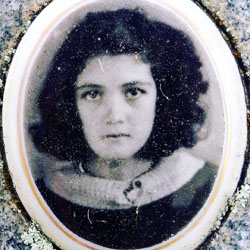 Her eyes haunt me. This is 13-year-old Hazel Pierson. She died March 18, 1937 in the New London, Texas Junior & Senior High School, when an explosion leveled much of the two-story brick and steel building. It was a Thursday, 15 minutes before the end of the school day. The kids were scheduled to be off that next day.
Her eyes haunt me. This is 13-year-old Hazel Pierson. She died March 18, 1937 in the New London, Texas Junior & Senior High School, when an explosion leveled much of the two-story brick and steel building. It was a Thursday, 15 minutes before the end of the school day. The kids were scheduled to be off that next day. The town lost 288 children in the 5th – 12th grades. A total of 311 people lost their lives or were severely injured in an event known as “The Day a Generation Died.” Some families lost two children. One family, three.
The town lost 288 children in the 5th – 12th grades. A total of 311 people lost their lives or were severely injured in an event known as “The Day a Generation Died.” Some families lost two children. One family, three.
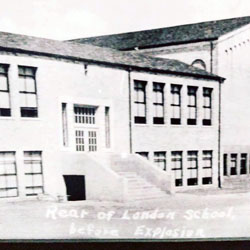 Rescuers, many from nearby oil fields worked far into the next day, removing the dead and wounded from under tons of debris. A 22-year-old named Walter Cronkite was one of the first reporters on the scene.
Rescuers, many from nearby oil fields worked far into the next day, removing the dead and wounded from under tons of debris. A 22-year-old named Walter Cronkite was one of the first reporters on the scene. up in the crawl space under the school. When the shop teacher turned on a sander, a spark triggered an explosion that was so powerful it sent a 1,500 pound piece of the concrete floor 200 feet in the air crushing a nearby car.
up in the crawl space under the school. When the shop teacher turned on a sander, a spark triggered an explosion that was so powerful it sent a 1,500 pound piece of the concrete floor 200 feet in the air crushing a nearby car. A new school was built on the site and it opened in 1939. It is still being used. A memorial to the victims with each name and their grade of stands nearby.
A new school was built on the site and it opened in 1939. It is still being used. A memorial to the victims with each name and their grade of stands nearby.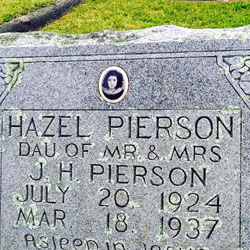 site today. I also visited a nearby cemetery where 112 children, including Hazel with the haunting eyes is laid to rest.
site today. I also visited a nearby cemetery where 112 children, including Hazel with the haunting eyes is laid to rest.





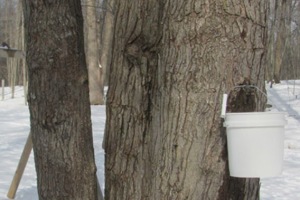 I tapped three trees. I think they were all Sugar Maples. I have to admit that I didn’t mark them last summer like I should have, and so when it came time this March to tap my trees, I could only remember one of them as a sugar maple. In theory, the bark should have helped me recognize them, but it didn’t. During my search, I ended up tapping three oaks before I finally found the two maples I needed. (Since oaks don’t give sap, it was evident early on that the trees weren’t maples and I was the only sap.)
I tapped three trees. I think they were all Sugar Maples. I have to admit that I didn’t mark them last summer like I should have, and so when it came time this March to tap my trees, I could only remember one of them as a sugar maple. In theory, the bark should have helped me recognize them, but it didn’t. During my search, I ended up tapping three oaks before I finally found the two maples I needed. (Since oaks don’t give sap, it was evident early on that the trees weren’t maples and I was the only sap.) 

 And I boiled and I boiled.
And I boiled and I boiled. 







